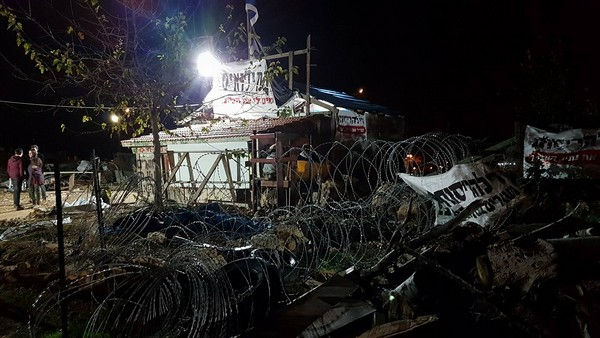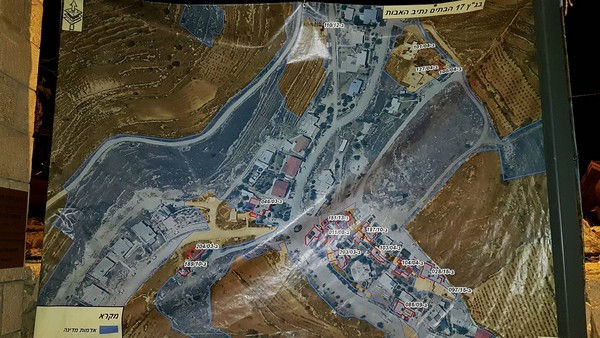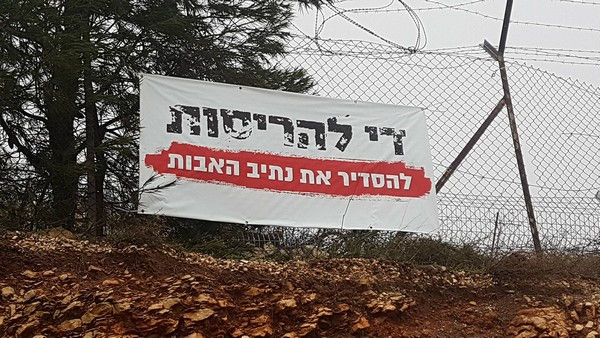What I Saw in Netiv Ha’avot - Spirit Versus Wanton Destruction
- Michael Miller
- Jan 21, 2018
- 6 min read
Updated: Dec 14, 2020

Netiv Ha'avot (Image credit: Michael Miller)
Despite the inclement weather with its downpour of rain and gusty winds, I made it to the neighborhood of Netiv Ha’avot in Elazar, Gush Etzion, where a group of homes is slated for unnecessary destruction. As someone once told me, “If you really want to be there, you will find a way; if not, you’ll just find an excuse.”
The following is what I heard and saw there on the ground over a unique Shabbat experience - this is “real news,” not the spin that is to be heard in nearly all of the Israeli “fake news” outlets reporting on the town.
I reached Elazar after a 15-20 minute bus ride from Jerusalem and went to the central synagogue to sign up for an energizing and uplifting shabbaton experience along with dozens upon dozens of Jews from all over the country. After being assigned a host family I started making my way by foot to their house - I thought I was going to end up in a huge communal tent like I was in Amona, before it was destroyed, but this time I was fortunate to have comfortable accommodations and hospitable hosts.
As I was walking up the hill to the house, a sweet couple from the town noticed I was schlepping a huge bag in the rain and decided to give me a ride to my hosts’ home, in a true testament to the character of the residents. After putting my things down, I went back to the synagogue to get my friends who were coming all the way from Tel Aviv. While I was walking in the rain again, someone else pulled over to the side of the road and asked me if I was okay or needed a lift somewhere. A truly heartwarming community.
(Video credit: Boomerang - Fighting For Israel)
My friends ended up being assigned to the same home as I was, so after getting them situated we got dressed for Shabbat and made our way to the Netivei Yochai Shul in Netiv Avot. The vibrations and energy of the spirit of the high-schoolers and locals during Kabbalat Shabbat were truly remarkable not only to witness but to feel and internalize. We all formed two huge dancing circles of dancing despite the small size of the shul and the ruach (spirit) was simply incredible to see; it was enough to bring you to tears witnessing one nation with one heart. We brought in Shabbat with a bang!
Following the prayers, we returned to our hosts’ house for a delicious fish dinner, and were treated to absolutely scrumptious food, inspiring divrei torah, and an adorable and welcoming family. As soon as we finished dinner, we headed to the central synagogue where we enjoyed a nicely-led singing tisch gathering that included more songs and more dancing circles with the youth of Elazar, and the girls sang and danced even better!

Israeli flag in Netiv Ha'avot (Image credit: Michael Miller)
The rabbi of the town said some words of wisdom, noting that as Jews in Eretz Yisrael (the Land of Israel), we have an obligation to care for one another because we are all family. “In the land of Israel, we don’t only worry about the individual; we worry about the entire nation, because it’s our obligation and duty to do so,” he said. This was followed by more energetic singing and songs of Jewish pride.
After the singing and dancing, we headed back to our hosts’ house and went to sleep. The following morning I went to shacharit in the central synagogue, which was spiritually uplifting and energizing. Prayers were followed by lunch at our hosts’ place, where they served us meat, potatoes, chicken, and rice.
A Harsh Dose of Reality
In the Netiv Ha’avot synagogue we were given a post-lunch tour by Ronan Malik, a resident of the community for the past 15 years. He explained to us the history of the place as well as the complicated politics and legalities that the residents are currently dealing with.
This is where our visit went from being a purely uplifting experience to a very sobering one as well.
Malik explained Netiv Ha’avot started back in 2001, during the second Intifada terror war. It began when a few idealistic Yemenite Jews decided to move into the area, and now the community houses dozens of families. “In the Gush Etzion area, the way we build here is by simply building, and amidst the building the Israeli government has been trying since 2001 to legalize the area and officially declare the land ‘state-land,’ because there is a need for Jewish presence in the Gush Etzion bloc,” he said. However, the legalization is stuck in bureaucracy. That’s how most, if not all, of the towns here were built, including Efrat.
(Video credit: Boomerang - Fighting For Israel)
“Being that there’s no Israeli law applied in Judea and Samaria we need to do things indirectly here in order to build and get permits,” continued Malik. It took the Israeli government 14-15 years to investigate and declare 95% of Netiv Ha’avot as state-owned land, but there is a tiny sliver of land that the government says is not official state-land - nor is it so-called “private Palestinian” land.
In the meantime, the Jewish residents live their lives here on the mountain. Up until 2015, the government couldn’t decide the legal status of the remaining 5% of the area, claiming that it’s not state land, but it’s not “Palestinian” land either - so whose land is it?
To this very day the Israeli government doesn’t know who it belongs to, explained Malik, and so the Bagatz (Israeli Supreme Court) decided that since it is ownerless, the tiny, narrow strip of land that runs through the 15 houses need to be demolished - meaning that all 15 houses must be destroyed entirely.

Map showing the homes slated for demolition (Image credit: Michael Miller)
The residents petitioned Bagatz, asking, “Why destroy the entire house? We’ll just take out the part that the sliver of land runs through,” which is literally about a meter long in some cases. But Bagatz responded: “No, your entire house must be destroyed by March 6th.” What this means is that their houses can be destroyed anytime between now and that declared date.
A Symptom of a Bigger Problem
“Speaking for myself, I personally respect the Jewish and democratic nature of this country and respect the judges in the court, because even if I staunchly disagree with them they are my brothers, and we need to try and find a viable solution that works for everyone,” opined Ronan Malik.
“If I am indeed sitting on ‘private Palestinian land’ - if someone brings proof that he or she owns the land - I’ll gladly move elsewhere and build. I don’t want to sit and live on property that doesn’t belong to me. But the 5% - we don’t know who it belongs to. It’s not state nor ‘Palestinian.’ It’s destruction for the sake of destruction over a stupid meter. We are trying to pressure [Prime Minister Binyamin] Bibi [Netanyahu, [Education Minister Naftali] Bennett, and [Justice Minister Ayelet] Shaked to help us out in the matter,” he added.

"Enough of the demolitions, regularize Netiv Ha'avot" (Image credit: Michael Miller)
Although the land belongs to the residents, the government has placed the residents of Judea and Samaria in a messy, disastrous, and complicated legal situation. The fact that they have decided not to annex the region and to not decide anything regarding the status of these Jews is the bigger problem of which Bagatz is a mere symptom.
Judging on actions, which as everyone knows are louder than words, no one in the current government truly thinks and believes that the entire Land of Israel belongs to the Jewish people - every centimeter of it. No matter how much one is an idealist and screams to the heavens that this is our G-d given homeland, the current reality on the ground sadly and pathetically reflects otherwise due to our apathy, incompetence, and unwillingness to deal with the issues at hand.
The tour was very insightful, but made me incredibly frustrated and angry. Did I come home from the galut (exile) of New York only to live in another secular-“democratic”-Western-liberal-galut? Reality is bitter and painful.
Following the tour, we davened mincha in the Netivei Yochai Shul in Netiv Ha’avot, and ate seudah shlishit (the third meal of Shabbat) in the courtyard of the synagogue which was accompanied by songs of unity, pride, and hope for a better future for us all. One of the heads of Netiv Ha’avot encouraged us to spread the word about the difficult and ludicrous situation via Facebook, Twitter, Whatsapp, and the rest of social media.
Seeing the youth dance and sing kumzitz songs for seudah shlishit reminded me that Rabbi Meir Kahane HY”D was right when he said: “The youth are the future.” They really are. After praying maariv at our hosts’ home, we packed up our things, said farewell to Netiv Ha’avot, and went home.



































Comments